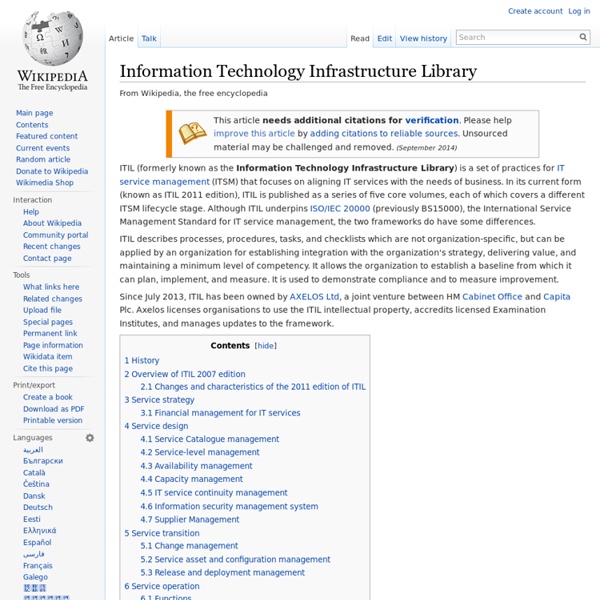ITIL? - What is ITIL?
ITIL is the most widely adopted approach for IT Service Management in the world. It provides a practical, no-nonsense framework for identifying, planning, delivering and supporting IT services to the business. ITIL: Overview and Benefits ITIL advocates that IT services must be aligned to the needs of the business and underpin the core business processes. It provides guidance to organizations on how to use IT as a tool to facilitate business change, transformation and growth. The ITIL best practices are currently detailed within five core publications which provide a systematic and professional approach to the management of IT services, enabling organizations to deliver appropriate services and continually ensure they are meeting business goals and delivering benefits. Adopting ITIL can offer users a huge range of benefits that include: For further information on the ITIL Service Management approach and its benefits, see ITIL: The Basics White Paper. Executive Briefing: ITIL Benefits.
itSMF France
yEd - Graph Editor
yEd is a powerful desktop application that can be used to quickly and effectively generate high-quality diagrams. Create diagrams manually, or import your external data for analysis. Our automatic layout algorithms arrange even large data sets with just the press of a button. yEd is freely available and runs on all major platforms: Windows, Unix/Linux, and Mac OS X. Key Features Import your own data from an Excel® spreadsheet (.xls) or XML Create diagrams with easevia an intuitive user interface. Automatically arrangeyour diagram elements. Export bitmap and vector graphicsas PNG, JPG, SVG, PDF, SWF yEd in 90 seconds Supported Diagrams yEd supports a wide variety of diagram types. Support Resources The yEd online support resources include the yEd Graph Editor manual and the yEd forum where you can give us feedback.
ITIL
Can ITIL Work Without All-or-Nothing Approach?
Tips on completing a successful IT Infrastructure Library (ITIL) initiative. For every like the often-related example of Johnson & Johnson that Blue Elephant Consulting's Jim Anderson writes about on blog, there's a less successful implementation. In many cases, resistance to the structure imposed by ITIL, from business users and/or IT staff, is a big problem. (Resistance may have been an issue at J&J, though Anderson's post only emphasizes the benefits the company attributes to ITIL, including what it says are annual IT savings in the neighborhood of $30 million.) Resistance to ITIL can be so great that Patrick Bolger, chief marketing officer for service management software provider Hornbill, told me his company advocates starting small, addressing obvious pain points, and He said: We advise them not to talk about ITIL, which will probably raise some objections, but to talk about service improvement or "service first" or whatever they want to call it.
Dia draws your structured diagrams: Free Windows, Mac OS X and Linux version of the popular open source program
ITIL - IT Service Management Books
IT Process Maps
Do You Write The Way You Speak? (You Should!) : The Public Speaker
Do you know how to write and deliver for the ear (and not the eye)? It’s not as easy you might think. But it’s definitely worth the effort because it’s the most effective form of communication. Remember when you were in school and your teacher told you not to write like you speak? Podcast, online videos, webinars, blog posts…really all digital content should to be written and delivered in a natural conversational style. Here are the first 4 tips: Tip #1: Think and Speak Your Content First The first step is to think about your content. After I’ve given the topic enough thought, I sometimes go for a drive to capture my thoughts on a digital recorder. If I try to directly type content first, I find myself editing along the way. Tip#2: Outline Your Content Another option is outlining. Remember, when you deliver the content, it doesn’t need to be exactly in the order it was prepared. Tip #3: Keep Your Sentences Short. Could you hear how awkward that sounded? Verbal language is simplistic. Not
ITIL® - What is ITIL?
ITIL is the most widely adopted approach for IT Service Management in the world. It provides a practical, no-nonsense framework for identifying, planning, delivering and supporting IT services to the business. ITIL: Overview and Benefits ITIL advocates that IT services must be aligned to the needs of the business and underpin the core business processes. It provides guidance to organizations on how to use IT as a tool to facilitate business change, transformation and growth. The ITIL best practices are currently detailed within five core publications which provide a systematic and professional approach to the management of IT services, enabling organizations to deliver appropriate services and continually ensure they are meeting business goals and delivering benefits. Adopting ITIL can offer users a huge range of benefits that include: For further information on the ITIL Service Management approach and its benefits, see ITIL: The Basics White Paper. Executive Briefing: ITIL Benefits.



